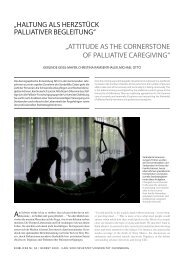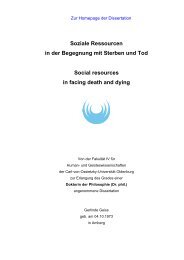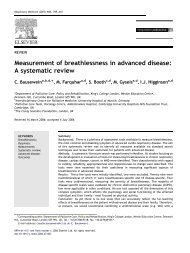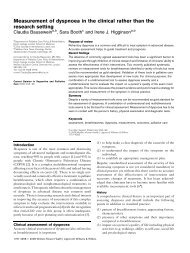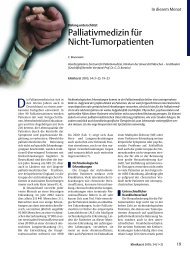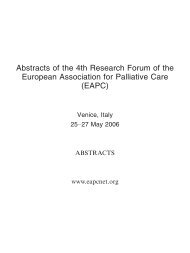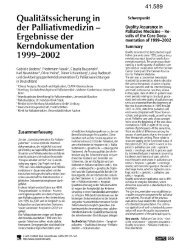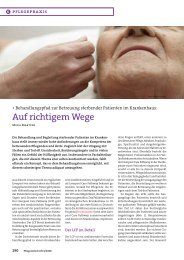EAPC - ipac
EAPC - ipac
EAPC - ipac
You also want an ePaper? Increase the reach of your titles
YUMPU automatically turns print PDFs into web optimized ePapers that Google loves.
420 <strong>EAPC</strong> Abstracts<br />
Head&Neck and Pancreas cancer, incomplete in the rest PSG. 4. UGC<br />
incomplete in all; absent in Pancreas cancer. 5. ADC incomplete in all;<br />
absent in Kidney and Pancreas cancer. DC and PC symptoms varied, except<br />
for DC complete in Colorectal and Pancreas cancer. Anxiety/depression;<br />
anorexia/early satiety; dyspnea/cough; nausea/vomiting; fatigue/lack of<br />
energy, belching/bloating consistently clustered. Conclusions: NVC was<br />
universal, DC complete in 2/7 PSG, NPC in Lung cancer. Primary site<br />
determined specific clusters, did not predict general cancer clusters, except<br />
for NVC, DC, and NPC.<br />
69 Oral Presentation<br />
Other symptoms<br />
“Now that you mention it doctor…”– Symptom reporting and<br />
the need for systematic questioning<br />
Presenting author: Damien McMullan<br />
Authors: Clare White Palliative Medicine Northern Ireland Hospice Care<br />
UNITED KINGDOM<br />
Julie Doyle Northern Ireland Hospice Care Belfast UNITED KINGDOM<br />
Damien McMullan Northern Ireland Hospice Care Belfast UNITED<br />
KINGDOM<br />
Barbara Cochrane Northern Ireland Hospice Care Belfast UNITED<br />
KINGDOM<br />
Background: Palliative care patients may experience a wide variety of<br />
symptoms. Some may be self-reported and some are only detected on systematic<br />
questioning (SQ). This review aims to determine the symptoms<br />
experienced by patients admitted to a specialist palliative care unit (SPCU),<br />
which of these are self-reported (SR) and which are only detected with the<br />
use of SQ. Methods: A retrospective review was performed of the charts of<br />
50 randomly selected patients who were admitted to a SPCU over a 2 year<br />
period. The standard admission proforma was reviewed to determine which<br />
symptoms were present on admission, which were SR and which were only<br />
detected upon SQ. Results: All 50 charts were included. 48 patients had<br />
advanced malignancy and 2 had advanced non-malignant disease. An average<br />
of 12.6 symptoms were experienced (SR+SQ) per patient on admission<br />
(range 5–21). 42 different symptoms were SR, with an average of 4.1 per<br />
patient (range 0 to 10). The most common SR symptoms were pain (72%),<br />
bowel disturbance (32%), nausea or vomiting (30%), mobility problems<br />
(30%), loss of appetite (24%) and low mood (22%). On SQ of 38 common<br />
symptoms, there was an average of 8.5 further symptoms per patient detected<br />
(range 1 to 18). The most common symptoms detected on SQ that were<br />
not SR were weight loss (66%), fatigue (56%), loss of appetite (48%),<br />
mobility problems (42%), oedema/ lymphoedema (36%), oral symptoms<br />
(36%), confusion/ memory loss (36%), sleep problems (36%), bowel disturbance<br />
(34%), drowsiness (32%), low mood (28%), and anxiety (26%).<br />
Conclusions: Patients appear to have many symptoms which are not SR on<br />
admission to a SPCU. SQ therefore plays a vital role in the detection of<br />
symptoms that may require further assessment or treatment. We speculate<br />
that under-reporting of symptoms may occur for several reasons e.g. if the<br />
patient does not consider these problematic or perceives them as unimportant<br />
to the medical team. More research is needed to further explore what<br />
symptoms are not SR and reasons for this.<br />
70 Oral Presentation<br />
Other symptoms<br />
Psychostimulants for depression: a Cochrane systematic<br />
review<br />
Authors: Bridget Candy Department of Mental Health Sciences, Royal Free<br />
and University College Medical School UNITED KINGDOM<br />
Louise Jones Royal Free and UCL Medical Scool London UNITED<br />
KINGDOM<br />
Rachael Williams Royal Free and UCL Medical Scool London UNITED<br />
KINGDOM<br />
Michael King Royal Free and UCL Medical Scool London UNITED<br />
KINGDOM<br />
Adrian Tookman Marie Curie Cancer Care London UNITED KINGDOM<br />
Background: Depression is common, disabling, costly and under-treated.<br />
There are problems in the current first-line drug treatment, antidepressants<br />
particularly time to effect. There is little evidence to inform treatment of those<br />
who do not respond and those, such as patients in palliative care, who would<br />
benefit from a faster response. There is a body of research that has evaluated<br />
effect of psycho-stimulants (PS) in the treatment of depression. This has not<br />
been reviewed systematically. Methods: Aim: To determine the effectiveness<br />
of PS in the treatment of depression. Eight citation databases, including<br />
MEDLINE, and EMBASE were searched. Only randomised controlled trials<br />
(RCTs) were included. Meta-analysis was considered for trials with comparable<br />
characteristics. Results: Twenty-four RCTs were identified. The overall<br />
quality was poor. Five PS were evaluated: dexamphetamine, methylphenidate,<br />
methylamphetamine, modafinil and pemoline. PS were administered as a<br />
monotherapy, adjunct therapy, in oral or intravenous preparation and in comparison<br />
with a placebo or an active therapy. Effects were measured up to<br />
24 weeks. The largest meta-analyses involved seven trials totalling 605 participants,<br />
it demonstrated that, in comparison with a placebo, PS significantly<br />
reduced depressive symptoms (Standardised Mean Difference –0.22, 95%<br />
Confidence Interval –0.38, –0.06). Pooled evidence also demonstrated that PS<br />
significantly improved daytime sleepiness, a symptom associated with<br />
depression. The overall effect was greater in patients who had serious concomitant<br />
medical illnesses. PS were acceptable to patients and well tolerated.<br />
Conclusions: There is evidence that PS reduce symptoms of depression.<br />
Whilst these reductions are statistically significant, their clinical significance<br />
is less clear. Larger high quality trials involving longer follow-ups are needed<br />
to explore which PS are more beneficial, in which clinical situations they are<br />
optimal, and to evaluate further adverse events.<br />
71 Invited Lecture<br />
Subjective outcomes in palliative care research and their analysis<br />
The role of patient reported outcomes in clinical research –<br />
EMEA and FDA Guideline documents<br />
Authors: Giovanni Apolone Lab. Tralsational Research & Outcome in<br />
Oncology Istituto Mario Negri, ITALY<br />
Ratings and reporting from patients are often used in clinical practice and<br />
research to evaluate the effect of a given intervention (for example, a drug)<br />
on relevant aspects of health, life or health care, such as pain, physical limitations<br />
or other symptoms, self-perceived health status, quality of life, satisfaction<br />
with care, etc. These measures, sometimess named with the term<br />
of “subjective outcomes” or “soft endpoints”, are most of the times implemented<br />
through self-reported questionnaires and may be used in clinical trials<br />
as primary or secondary endpoints. Pharmas extensively use PRO measures.<br />
A recent evaluation and preliminary analysis of the European Public<br />
Assessment Report (EPAR) has shown that in at least 25% of the EPAR<br />
reports there is a claim about Health Related-Quality of Life, mostly in<br />
cancer-related products. Although the large utilization, their value are questionated<br />
for the difficulty to document their validity, reliability and responsiveness<br />
and for the complexity of their implementation in the studies. In<br />
addition, most of the times it is not easy to assess the added value of their<br />
utilization when compared to the classical clinical outcomes. Of course, in<br />
some clinical situations where the patients’ perspective is the most relevant<br />
or unique point-of view, the trade-off of pros (increase in the amount of relevant<br />
information about disease, health status and satisfaction) and cons<br />
(conceptual, methodological and logistical problems) is different. All these<br />
measures have been recently grouped under the term of PRO (patientreported<br />
outcomes) and both FDA and EMEA have produced and diffused<br />
guidance documents to optimize their utilization in clinical studies designed<br />
for registrative purposes. An analysis of the objectives, contents and recommendations<br />
of both documents can help better understand the potential<br />
value of these measures in palliative care and increase the quality of clinical<br />
studies in this setting.



